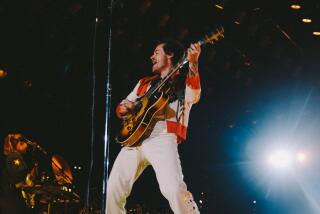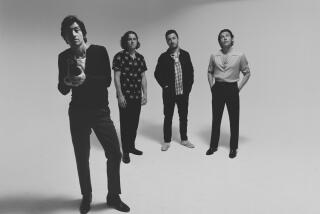Maybe Connick’s Swing Didn’t Mean a Thing : Pop music review: The crooner changes direction, aggressively trying his hand at funk, multiple instruments and impressions as he roams the concert stage.
- Share via
IRVINE — Goodby, Frank Sinatra. So long, Duke Ellington. See you later, Nat Cole.
Harry Connick Jr.’s got another new identity, and it’s none of that old-time stuff. Forget the crooner business. Forget the slick orchestrations. Who needs a big band or a jazz trio? Harry’s decided to be . . .
A rock star!
And a multi-instrumentalist. And an impressionist. And a few other things, as well--like that serial killer role in “Copycat.”
Connick’s performance at UC Irvine’s Bren Events Center on Tuesday with his newly formed “funk band” was a study in aggressive, in-your-face egocentricity. Dressed in muscle-baring black undershirt, his hair cropped fashionably short, roaming the stage with the restless energy of a youthful Mick Jagger, he had all the rock star moves, determinedly focusing the attention on himself.
His audience, which filled perhaps two-thirds of the Bren Center’s sports arena setting, replied with occasional obligatory screams, and sporadic chants of “Harry, Harry, Harry!” But the crowd reaction was more directed than responsive. Told to stand, they stood; told to applaud, they briefly clapped in rhythm.
Yet, ironically, Connick’s funk metamorphosis was only slightly less retro than his earlier Sinatra/Ellington/Cole transformations. He did several tunes, such as “Here Comes the Big Parade,” from his current funk-oriented album, and dipped into one or two raucous Cajun rhythms and a bit of New Orleans jazz.
But he also did a good-time rendering of Sly & the Family Stone’s “Thank You (Falettinme Be Mice Elf Again)” with no obvious awareness of the song’s dark undercurrents. And, despite driving guitar work from Jonathan Dubose and Lucien Barbarin’s spirited trombone playing, few of the readings approached either the authenticity or the vitality of their ‘70s models.
Not content to simply stay with his funk image, Connick bounced from instrument to instrument, playing--in addition to his acoustic and electric pianos and organ--trumpet, guitar and drums. Aside from their show-off aspects, his multi-instrumental performances didn’t add much more than yet another reason for him to remain in the center of the spotlight.
As if that weren’t enough, at one point Connick broke away from the music, pacing back and forth, preaching about the irrelevance of color and the importance of living together peacefully--”Ya understand what I’m saying?”
Then, in curious contradiction, he followed his togetherness rap with impressions of the Rev. Jesse Jackson, Mike Tyson and Frank Sinatra, a tasteless parody of Judy Garland and a gratuitous slap at Michael Jackson.
So where’s the real Harry Connick? Only Connick knows. And maybe this was all there is: a little of this, a little of that. Nothing completed or polished or thoroughly developed. Another chapter for an entertainment persona that seems to unveil a new transmutation every year or so, but never quite evolves into a full-fledged creative artist.
If so, it would be a shame. His missteps in judgment aside, Connick worked hard at the Bren Center. And, as in most of his performances, the reality of his talent was crystal clear, even though it was filtered through far too many opaque lenses. Even his most egregiously self-indulgent, over-amplified numbers contained small, attractive gems of musical truth.
But Connick badly needs some focus--some sense of direction for a talent that, despite its successes, appears rudderless, moving in random headings, hoping to find a meaningful destination beyond the next horizon.
More to Read
The biggest entertainment stories
Get our big stories about Hollywood, film, television, music, arts, culture and more right in your inbox as soon as they publish.
You may occasionally receive promotional content from the Los Angeles Times.










